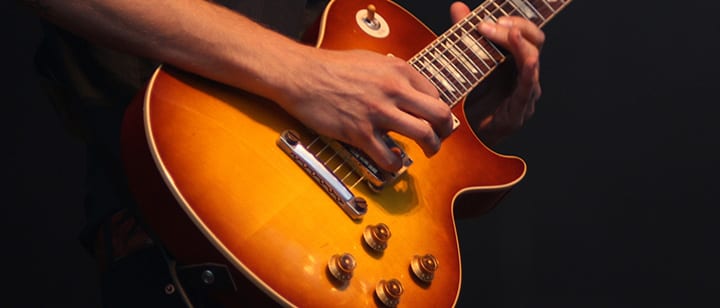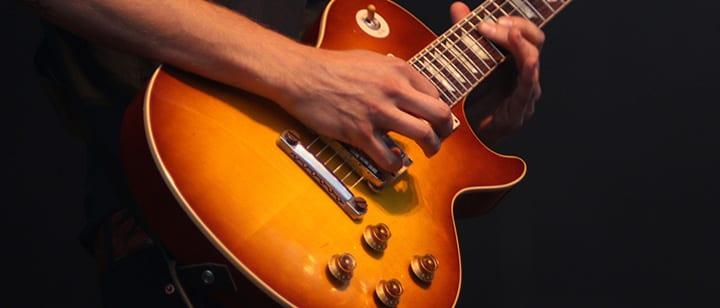 Are you stuck in a musical rut? New tunings and tricks can help you keep learning guitar in fresh, fun ways. Try one of these great tips from guitar teacher Samuel B. to breathe new life into your guitar playing…
Are you stuck in a musical rut? New tunings and tricks can help you keep learning guitar in fresh, fun ways. Try one of these great tips from guitar teacher Samuel B. to breathe new life into your guitar playing…
One of the first things I tell any new student is that I don’t specialize in a formal discipline. If jazz or classical training is your objective, then I’m not your guy. Instead, I specialize primarily in American roots music (that which we tend to casually lump together as “folk” and/or “rock”). Fortunately, my sharing this information has not prompted any student to pick up their instrument and walk out the door.
Although it took me literally years to buy it, a collaborator from my college days introduced me to the idea that any musician can bridge stylistic gaps with a few simple tricks. At the time, my position was that I was a blues-rock guitarist and that’s all there was to it.
However, a simple repeated lick I contributed to a song that he and I compiled a few years later (involving a single minor chord and an effects pedal) introduced a Latin-sounding slant to our primarily standard American sound. If you’re stuck in a stylistic box, sometimes simple things can add a little more spice to your guitar playing.
Branching Out Into Jazz
In many ways, the Blues, Country music, Appalachian sounds (particularly Bluegrass), Gospel, campfire songs, and all forms of singer-songwriter material are really six different versions of the same thing. First of all, they are all based around the same three chords (the ones that are based on the first, fourth, and fifth notes of a scale – C, F and G7th for example). Patterns involving these three chords make for everything you will learn in the first three keys (C, D, and E) I will teach you.
Playing formal jazz (another basic yet more structurally complex form of American music) involves memorizing not only complex advanced scales, but also chords involving several variations (ie minor seventh suspended) a piece. As indicated, I can’t claim relevant training or even the ability to sight-read any chord with more than two variations to its name. However, two simple alternate chord formations will transform a standard one-four-five American roots pattern into the more complex structure of a standard jazz tune.
In a previous article, I introduced triads as a precursor to learning barre chords:
E|———|———|———|
B|———|———|———|
G|———|—-O—|———|
D|—-O—|———|———|
A|———|———|———|
E|—-O—|———|———|
E|———|———|———|
B|———|———|———|
G|———|—-O—|———|
D|—-O—|———|———|
A|———|—-O—|———|
E|———|———|———|
These two formations (based on the first-position E and B7th chords respectively) make for colorful alternatives to first-position major chords when played together in a one-four-five pattern. Just play the first one a full step – two frets – up from whichever position in which you’re alternating between it and the other one to complete said pattern.
They also make for wonderful experimental material. Just a few dry runs up and down the neck of ANY combination of them create the sonic territory of a solo jazz guitar piece. I also recommend experimenting with finger-picking patterns to effectively create melodies to accompany the complex progressions you’ll be creating.
Experimenting With An Open Tuning
The best way to enliven your sound without shifting genres is to tune to an open chord. Open D (D, A, F#, D, A, D) is customary for the six genres I cited above. I recently recorded a collaborative album on which I used this tuning exclusively. Predictably enough, strumming it openly produces a “D” chord. Placing one finger (I recommend the thumb) over the bottom four strings produces major chords theoretically identical yet aurally distinct from the ones in first position (standard tuning).
D |———|———|———|
A |———|———|———|
F#|———|—-O—|———|
D |———|—-O—|———|
A |———|—-O—|———|
D |———|—-O—|———|
Play around with this tuning (up and down the neck – as with the triads). Try variations such as holding down the bottom THREE strings instead. After all, the fourth one is the middle (third) degree of the chord – the one that determines whether the chord is major, minor, augmented, diminished, or perhaps some other lesser-known yet equally compelling label.
Open tunings are commonplace for many household artists. Joni Mitchell uses them exclusively. Neil Young, Keith Richards, and John Mellencamp are also frequent subscribers. My inspiration for using and sharing the “thumb” chords is Richie Havens who had relevant instructional material published before his recent death. Open tunings are ideal territory for experimenting with open-handed picking and/or slide techniques (involving the use of a glass or steel tube on the pinkie finger).
See what works best for you, and keep having fun learning guitar!

Samuel B. teaches beginner guitar lessons in Austin, TX. He teaches lessons face-to-face without sheet music, which is his adaptation of Japanese instruction (involving a call-and-response method). Learn more about Samuel here!
Photo by blondinrikard
Suzy S.

